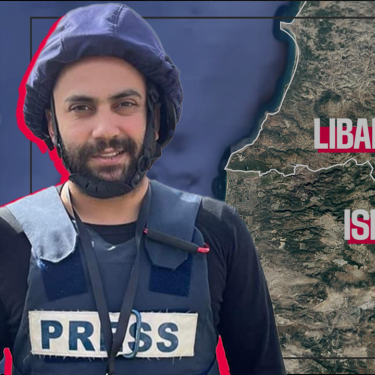RSF video investigation into the death of Reuters reporter Issam Abdallah in Lebanon: the journalists' vehicle was explicitly targeted

Reporters Without Borders (RSF) has released a video reconstruction of the tragedy that resulted in the death of one journalist and the injury of several others. The initial findings of the investigation show that the reporters were not collateral victims of the shooting. One of their vehicles, marked "press", was targeted, and it was also clear that the group stationed next to it was journalists.
What happened on the border between Israel and Lebanon on Friday 13 October when a bombing raid claimed the life of Reuters journalist Issam Abdallah? Two strikes of different intensity, about thirty seconds apart, hit the exact spot where seven journalists were standing. They had set up in this area to cover the exchange of fire between Hezbollah forces and the Israeli army. The first strike killed Reuters photojournalist Issam Abdallah and seriously injured Agence France-Presse (AFP) correspondent Christina Assi, while the second blew up the Al Jazeera vehicle in the immediate vicinity, injuring several of their colleagues.
Blamed for the incident by various witnesses, the Israeli army immediately declared that it was "sorry" and that it was “looking into it.” . A week after the events, RSF is reconstructing what may have happened between 4.45pm, the time of the first images collected, and around 6pm, the time of the death of Issam Abdallah, aged 37, in Alma el-Chaab, southern Lebanon. The sources include videos filmed at the very moment of the tragedy and ballistic analysts commissioned by RSF.
At this stage, RSF's investigation can conclude that :
- On Friday 13 October, at around 6.00 pm, two strikes of different intensity, 37 to 38 seconds apart, hit the spot where a group of seven journalists had been for more than an hour. The first killed Reuters photojournalist Issam Abdallah, according to his colleagues who were with him.
- The second, more powerful strike, with a payload of more than 3 kg TNT equivalent according to RSF's ballistic expertise, ignited the Al Jazeera vehicle, a white Toyota, next to which the reporter was standing, injuring Al Jazeera journalists Carmen Joukhadar and Elie Brakhya, as well as their AFP colleague Dylan Collins. The strike displaced the vehicle by around 90 degrees from its original position.
- According to the ballistic analysis carried out by RSF, the shots came from the east of where the journalists were standing; from the direction of the Israeli border.
- Two strikes in the same place in such a short space of time (just over 30 seconds), from the same direction, clearly indicate precise targeting.
- It is unlikely that the journalists were mistaken for combatants, especially as they were not hiding: in order to have a clear field of vision, they had been in the open for more than an hour, on the top of a hill. They were wearing helmets and bullet-proof waistcoats marked "press". Their car was also identified as "press" thanks to a marking on the roof, according to witnesses.
- At around 4.45pm, one of the Al Jazeera journalists interviewed in the video spotted an Israeli helicopter flying over the area and was able to spot the journalists. The reporters were therefore identified in the area by the forces present before the bombing.
- An Israeli Apache helicopter flew over the scene a few seconds before the tragedy, according to Edmond Sassine, journalist with the Lebanese television station LBCI, who was stationed around a hundred metres from his colleagues from Reuters, Al Jazeera and AFP.
- Five days earlier, on 9 October, the Al Jazeera journalists had suffered a similar attack in the village of Dhayra in southern Lebanon: according to their testimonies, an Israeli helicopter flew over them before a missile fell next to their car – of the same model as the one bombed on 13 October – also bearing the word "press".
RSF is continuing its investigation.
